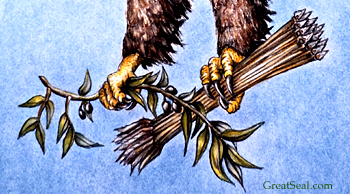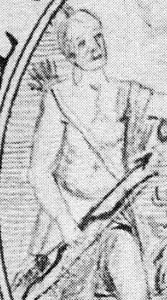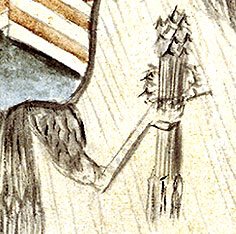|
Main Pages
Front Page
Overview
Seal FAQs
Design Process
1st Committee
2nd Committee
3rd Committee
Final Design
Description
Explanation
Latin Mottoes
E Pluribus Unum
Annuit Coeptis
Novus Ordo Seclorum
Symbols (front)
Bald Eagle
Shield
Olive Branch
Arrows
Stars
Rays of Light
Cloud
Symbols (back)
Pyramid
Eye
MDCCLXXVI
Great Seals
Official Dies
First Engravings
First Painting
1792 Medal
Indian Medals
1882 Medal
One-Dollar Bill
Myths
Eagle Side
Pyramid Side
Themes
Unity
Peace
Liberty
Thirteen
Related
Wild Turkey
President's Seal
Sightings
Resources
|

The Bundle of Thirteen Arrows
in the Eagle's Left Talon on the U.S. Seal
 Arrows were first suggested by Francis Hopkinson, the consultant and artist on the second Great Seal committee. In his preliminary design, one of the figures supporting the shield was an Indian warrior holding a bow & arrow and carrying a quiver of arrows (shown here). The other figure was a lady representing Peace bearing an olive branch. Beneath them was a Latin motto that meant "Prepared in War or in Peace."
Arrows were first suggested by Francis Hopkinson, the consultant and artist on the second Great Seal committee. In his preliminary design, one of the figures supporting the shield was an Indian warrior holding a bow & arrow and carrying a quiver of arrows (shown here). The other figure was a lady representing Peace bearing an olive branch. Beneath them was a Latin motto that meant "Prepared in War or in Peace."
When Charles Thomson put together the final design for the Great Seal, he placed a bundle of arrows in the eagle's left (sinister) talon. The official description specifies the bald Eagle holding "in his sinister a bundle of thirteen arrows."

The official explanation describes the symbolism: "The Olive branch and arrows denote the power of peace & war which is exclusively vested in Congress."

In heraldry, the symbol in a figure's right hand is more significant than the one in its left hand. All dies of the Great Seal have shown the American eagle facing the olive branch on its right side – further emphasizing the power of peace. The eagle on the Seal of the President, however, used to face the arrows.

Charles Thomson specified a bundle of arrows, and in his preliminary sketch (above) showed the thirteen arrows tightly aligned – a symbol of "strength in unity" that's found in the traditional cultures everywhere, from the Romans to the Iroquois.
We Are Unbreakable
Rabbi Marc Gellman
A Prayer for America, Yankee Stadium, September 23, 2001
The Talmud and the African tribe, the Masai tribe, both teach a wisdom for our wounded world. They both taught:
Sticks alone can be broken by a child, but sticks in a bundle are unbreakable.
The fears and sorrows of this moment are so heavy, they can break us if we try to bear them alone. But if we are bundled together – if we stick together – we are unbreakable.
And we shall do far more than merely survive. We shall overcome. We shall overcome the forces of hatred, without allowing hatred to unbundle us. We shall overcome the forces of terror, without using fear to unbundle us.
So in all our comings and our goings, from this time forth, let us remember: That the person next to you, in front of you, behind you, is not merely an obstacle to your free and unfettered life. They are a part of this bundle, that keeps you and each of us from breaking.
Let us never again view our fellow New Yorkers, our fellow Americans, our fellow citizens of the world, as limitations on our life or freedom. But rather as the moral twine that binds us, and saves us, and delivers us from evil.
|
A bundle of arrows was also an emblem on early paper money.
"After much occasion to consider the folly and mischiefs of a state of warfare, and the little or no advantage obtained even by those nations who have conducted it with the most success, I have been apt to think that there has never been, or ever will be, any such thing as a good war, or a bad peace." – Benjamin Franklin to Jonathan Shipley, June 10, 1782
|
The Eagle and the Arrow – An Aesop's Fable
An Eagle was soaring through the air. Suddenly it heard the whizz of an Arrow, and felt the dart pierce its breast. Slowly it fluttered down to earth. Its lifeblood pouring out. Looking at the Arrow with which it had been shot, the Eagle realized that the deadly shaft had been feathered with one of its own plumes.
Moral: We often give our enemies the means for our own destruction.
|
|

